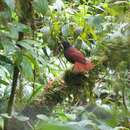tr
kırıntılardaki isimler


The brown-winged whistling thrush (Myophonus castaneus), also known as the Sumatran whistling thrush or chestnut-winged whistling thrush, is a passerine bird belonging to the whistling thrush genus Myophonus in the family Muscicapidae. It is endemic to the island of Sumatra in Indonesia. In the past, it has often been lumped together with the Javan whistling thrush (M. glaucinus) and Bornean whistling thrush (M. borneensis) as the "Sunda whistling thrush" (M. glaucinus) but it is now often regarded as a separate species based on differences in plumage and measurements.
It is about 25 centimetres long. The black bill has an average depth of 7.3 millimetres, slenderer than the bills of the Bornean and Javan whistling thrushes. The legs and feet are dark brown. The adult male has a dark blue head, breast and shoulders with the rest of the plumage being chestnut. The adult female and immature are mostly dull chestnut-brown with a blue patch on the shoulder. The Bornean and Javan whistling thrushes lack any chestnut coloration.
It has a loud whistling call and a harsh grating call.
It occurs in montane forest from 400 to 1500 metres above sea-level. It is usually found near streams and typically keeps to the middle and subcanopy layers of the forest. It is a scarce bird and is believed to be declining as a result of deforestation.
The brown-winged whistling thrush (Myophonus castaneus), also known as the Sumatran whistling thrush or chestnut-winged whistling thrush, is a passerine bird belonging to the whistling thrush genus Myophonus in the family Muscicapidae. It is endemic to the island of Sumatra in Indonesia. In the past, it has often been lumped together with the Javan whistling thrush (M. glaucinus) and Bornean whistling thrush (M. borneensis) as the "Sunda whistling thrush" (M. glaucinus) but it is now often regarded as a separate species based on differences in plumage and measurements.
It is about 25 centimetres long. The black bill has an average depth of 7.3 millimetres, slenderer than the bills of the Bornean and Javan whistling thrushes. The legs and feet are dark brown. The adult male has a dark blue head, breast and shoulders with the rest of the plumage being chestnut. The adult female and immature are mostly dull chestnut-brown with a blue patch on the shoulder. The Bornean and Javan whistling thrushes lack any chestnut coloration.
It has a loud whistling call and a harsh grating call.
It occurs in montane forest from 400 to 1500 metres above sea-level. It is usually found near streams and typically keeps to the middle and subcanopy layers of the forest. It is a scarce bird and is believed to be declining as a result of deforestation.
El arrenga castaño[2] (Myophonus castaneus) es una especie de ave paseriforme de la familia Muscicapidae.[3]
Es endémico de las selvas montanas de Sumatra (Indonesia).[3][4]
Está amenazada por la pérdida de hábitat.
El arrenga castaño (Myophonus castaneus) es una especie de ave paseriforme de la familia Muscicapidae.
Myophonus castaneus Myophonus generoko animalia da. Hegaztien barruko Turdidae familian sailkatua dago.
Myophonus castaneus Myophonus generoko animalia da. Hegaztien barruko Turdidae familian sailkatua dago.
Myophonus castaneus
L'Arrenga à dos brun (Myophonus castaneus) est une espèce d’oiseaux de la famille des Muscicapidae.
Cet oiseau est endémique de l'île de Sumatra en Indonésie.
Les travaux phylogéniques de Sangster et al. (2010) et Zuccon & Ericson (2010) montrent que le placement traditionnel de cette espèce dans la famille des Turdidae est erroné, et qu'elle appartient en fait à la famille des Muscicapidae[1].
D'après le Congrès ornithologique international, c'est une espèce monotypique.
Myophonus castaneus
L'Arrenga à dos brun (Myophonus castaneus) est une espèce d’oiseaux de la famille des Muscicapidae.
De Sumatraanse fluitlijster (Myophonus castaneus) is een zangvogel uit de familie Muscicapidae (vliegenvangers).
Deze soort is endemisch op het Indonesische eiland Sumatra.
De Sumatraanse fluitlijster (Myophonus castaneus) is een zangvogel uit de familie Muscicapidae (vliegenvangers).
Kastanjevisseltrast[2] (Myophonus castaneus) är en fågel i familjen flugsnappare inom ordningen tättingar.[3] Den förekommer i skogar vid bergsfoten i Sumatra.[3] IUCN kategoriserar arten som nära hotad.[1] Den behandlas ibland som underart till Myophonus glaucinus.[4]
Kastanjevisseltrast (Myophonus castaneus) är en fågel i familjen flugsnappare inom ordningen tättingar. Den förekommer i skogar vid bergsfoten i Sumatra. IUCN kategoriserar arten som nära hotad. Den behandlas ibland som underart till Myophonus glaucinus.
Myophonus castaneus là một loài chim trong họ Muscicapidae.[1]
Myophonus castaneus là một loài chim trong họ Muscicapidae.